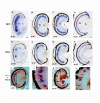Regulation of photoreceptor gene transcription via a highly conserved transcriptional regulatory element by vsx gene products
- PMID: 28003732
- PMCID: PMC5166794
Regulation of photoreceptor gene transcription via a highly conserved transcriptional regulatory element by vsx gene products
Abstract
Purpose: The photoreceptor conserved element-1 (PCE-1) sequence is found in the transcriptional regulatory regions of many genes expressed in photoreceptors. The retinal homeobox (Rx or Rax) gene product functions by binding to PCE-1 sites. However, other transcriptional regulators have also been reported to bind to PCE-1. One of these, vsx2, is expressed in retinal progenitor and bipolar cells. The purpose of this study is to identify Xenopus laevis vsx gene products and characterize vsx gene product expression and function with respect to the PCE-1 site.
Methods: X. laevis vsx gene products were amplified with PCR. Expression patterns were determined with in situ hybridization using whole or sectioned X. laevis embryos and digoxigenin- or fluorescein-labeled antisense riboprobes. DNA binding characteristics of the vsx gene products were analyzed with electrophoretic mobility shift assays (EMSAs) using in vitro translated proteins and radiolabeled oligonucleotide probes. Gene transactivation assays were performed using luciferase-based reporters and in vitro transcribed effector gene products, injected into X. laevis embryos.
Results: We identified one vsx1 and two vsx2 gene products. The two vsx2 gene products are generated by alternate mRNA splicing. We verified that these gene products are expressed in the developing retina and that expression resolves into distinct cell types in the mature retina. Finally, we found that vsx gene products can bind the PCE-1 site in vitro and that the two vsx2 isoforms have different gene transactivation activities.
Conclusions: vsx gene products are expressed in the developing and mature neural retina. vsx gene products can bind the PCE-1 site in vitro and influence the expression of a rhodopsin promoter-luciferase reporter gene. The two isoforms of vsx have different gene transactivation activities in this reporter gene system.
Figures




Similar articles
-
The Rx-like homeobox gene (Rx-L) is necessary for normal photoreceptor development.Invest Ophthalmol Vis Sci. 2006 Oct;47(10):4245-53. doi: 10.1167/iovs.06-0167. Invest Ophthalmol Vis Sci. 2006. PMID: 17003412 Free PMC article.
-
Negative regulation of Vsx1 by its paralog Chx10/Vsx2 is conserved in the vertebrate retina.Brain Res. 2008 Feb 4;1192:99-113. doi: 10.1016/j.brainres.2007.06.007. Epub 2007 Jun 18. Brain Res. 2008. PMID: 17919464 Free PMC article.
-
Regulation of photoreceptor gene expression by the retinal homeobox (Rx) gene product.Dev Biol. 2010 Mar 15;339(2):494-506. doi: 10.1016/j.ydbio.2009.12.032. Epub 2010 Jan 7. Dev Biol. 2010. PMID: 20060393 Free PMC article.
-
Vsx-1 and Vsx-2: differential expression of two paired-like homeobox genes during zebrafish and goldfish retinogenesis.J Comp Neurol. 1997 Nov 24;388(3):495-505. doi: 10.1002/(sici)1096-9861(19971124)388:3<495::aid-cne11>3.0.co;2-l. J Comp Neurol. 1997. PMID: 9368856
-
Vsx-1 and Vsx-2: two Chx10-like homeobox genes expressed in overlapping domains in the adult goldfish retina.J Comp Neurol. 1997 Oct 27;387(3):439-48. J Comp Neurol. 1997. PMID: 9335426
Cited by
-
Inherited Eye Diseases with Retinal Manifestations through the Eyes of Homeobox Genes.Int J Mol Sci. 2020 Feb 26;21(5):1602. doi: 10.3390/ijms21051602. Int J Mol Sci. 2020. PMID: 32111086 Free PMC article. Review.
References
-
- Batni S, Scalzetti L, Moody SA, Knox BE. Characterization of the Xenopus rhodopsin gene. J Biol Chem. 1996;271:3179–86. - PubMed
-
- Mani SS, Batni S, Whitaker L, Chen S, Engbretson G, Knox BE. Xenopus rhodopsin promoter. Identification of immediate upstream sequences necessary for high level, rod-specific transcription. J Biol Chem. 2001;276:36557–65. - PubMed
-
- Boatright JH, Borst DE, Peoples JW, Bruno J, Edwards CL, Si JS, Nickerson JM. A major cis activator of the IRBP gene contains CRX-binding and Ret-1/PCE-I elements. Mol Vis. 1997;3:15. - PubMed
-
- Ma GC, Wang TM, Su CY, Wang YL, Chen S, Tsai HJ. Retina-specific cis-elements and binding nuclear proteins of carp rhodopsin gene. FEBS Lett. 2001;508:265–71. - PubMed
Publication types
MeSH terms
Substances
Grants and funding
LinkOut - more resources
Full Text Sources
Research Materials
Miscellaneous

